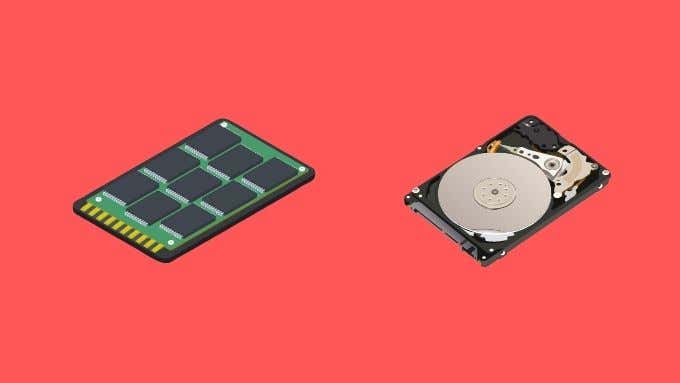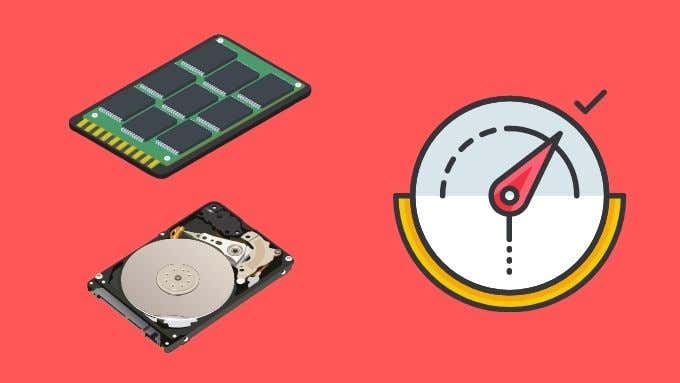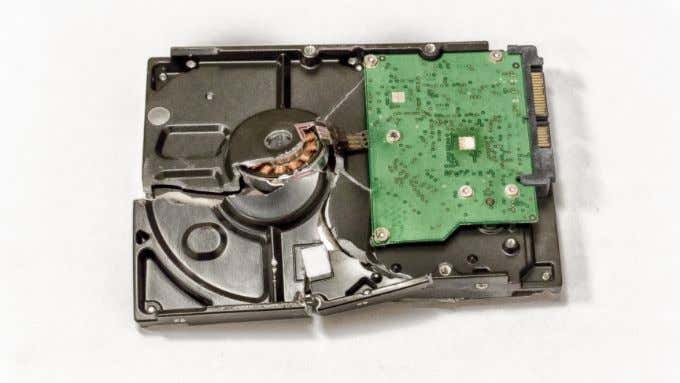When buying a hard drive today, you have three drive types: SSD, HDD or SSHD. This acronym soup might tempt you to just give up and go back to clay tablets, but we’ll help you figure out which is best for your needs.
What Are SSDs, HDDs and SSHDs
The obvious first step in all of this is to explain what these three drive types are and expand on what those acronyms actually mean. SSDs are Solid State Drives. They have no moving parts whatsoever and make use of solid state flash memory. HDDs are Hard Disk Drives. These are the traditional mechanical drives that were standard until quite recently. It uses spinning platters covered in a magnetic substance to store data. Tiny read/write heads flit across the surface of these disks floating on a cushion of air a fraction of a hair’s width. SSHDs are Solid State Hybrid Drives. The “hybrid” part of the name refers to the fact that these drives contain both solid state memory and spinning mechanical disks. Clever software inside the drive figures out which files should be loaded onto the solid state memory in the background. So when you want to access files that have been loaded onto the solid state cache, you’ll get similar performance to a pure SSD.
Performance
Speaking of performance, there’s a clear hierarchy when it comes to this comparison.
Solid State Drives
SSDs are the fastest type of drive in every comparison. A good quality SATA 3 SSD will more or less hit the limits of the connection type with read and write speeds at around 600MB/s. But SSDs also come in other formats, such as NVME. NVME SSDs with read and write speeds around 3500 MB/s are commonplace now and a new generation of drive that runs in excess of 5500 MB/s is on the horizon.
Solid State Hybrid Drives
SSHDs are only available as SATA drives, so they can never exceed the 600MB/s speed limit of the connection. Also, they can only achieve SSD speeds for short bursts of time. Basically for as long as the SSD cache has data in it. So the larger the SSD cache, the longer the amount of time it can sustain high data speeds. It also depends on whether the SSHD has pre-loaded the right files into the cache. If it hasn’t you’ll fall back to standard hard drive speeds.
Hard Disk Drives
Traditional hard drives are the slowest of the bunch. While high-end 7200 RPM drives can attain around 230MB/s and experimental drives have been shown hitting almost 500MB/s, the typical 5400 RPM drive you’ll find in a laptop or desktop computer comes nowhere near that. Speeds of between 30MB/s and 110MB/s are much more typical.
Physical Size
SSDs have been produced in 3.5” and 2.5” standard drive sizes using the SATA connector. In which case they take up the same volume as mechanical drives in those sizes. However, that’s for drive bay compatibility, there’s no actual need for them to be that large. NVME format drives are about as large as a stick of desktop PC RAM and sit tightly against the motherboard. Which means they take up no drive bays at all. SSHDs and HDDs are only available on 3.5” and 2.5” form factors. They are also significantly heavier than SSDs, so they will add to the bulk of the system, at least in relative terms.
Cost and Capacity
The cost of SSDs have come tumbling down over the last few years, but a quality drive will still command the highest price per gigabyte of any drive type. SSDs are also relatively limited in their maximum capacity. The largest drives are currently 2TB in size, but have eye-watering prices for that much space. So typically systems come equipped with 250GB to 500GB drives. That’s not much in a world of 100GB video games and 4K video! SSHDs and HDDs have similar pricing, with SSHDs costing a bit more thanks to the inclusion of a small bit of SSD storage and more sophisticated electronics and firmware. Both of these drive types have a low per-gigabyte cost and are offered in huge capacities, exceeding 10 TB at the high end.
Reliability
The water is a little muddy when it comes to the reliability of these different drive types. We have a huge amount of data when it comes to the reliability of mechanical drives. These typically have a MTBF (Mean Time Between Failures) of 100,000 hours. Failure is usually caused by mechanical components wearing out. So even if you don’t use your hard drive much, but it stays powered on, it will fail eventually. Theoretically SSDs should last forever, but the more affordable type of SSD memory you get in consumer drives wears out a little every time you write data to it. This is a complicated topic, so we suggest you read Everything You Need To Know About SSD Wear & Tear to get a good grasp of the issue. In modern high capacity SSDs, it’s not really a problem. SSD torture tests have shown them lasting far beyond their rated data writing lifespans. However, it does become a point of concern on an SSHD with a small SSD cache that is constantly being written to as a temporary holding space.
Recommended Use Cases
Now that we’ve covered the strong and weak points of these various drives, it’s time to talk about which drives are best for which use cases. SSDs are best used as system drives that host the operating system and applications that benefit from SSD speeds. These would include video editors, productivity applications and of course video games. Since they are expensive, SSDs are wasted on media files or data archiving. SSHDs are really only a sensible choice for laptop computers that only have a single drive bay. Whether it’s because your budget is limited or you need a lot of internal space, an SSHD offers some day-to-day performance increases while also offering plenty of cheap storage. HDD drives are perfect to store large media files, backups of video games and other applications and any other data types that don’t require SSD speeds to use. These drives are cheap and if you use external HDD drives that don’t run constantly, they also make for good backup solutions. In systems that can have multiple drives the optimal solution today seems to be an SSD main drive, with a large HDD as a secondary mass storage drive. However, with SSD prices going down and sizes going up, the future does seem to be purely solid state. We aren’t quite there yet, but the day when SSD storage is cheaper than HDD storage may not be as far away as you’d think.





